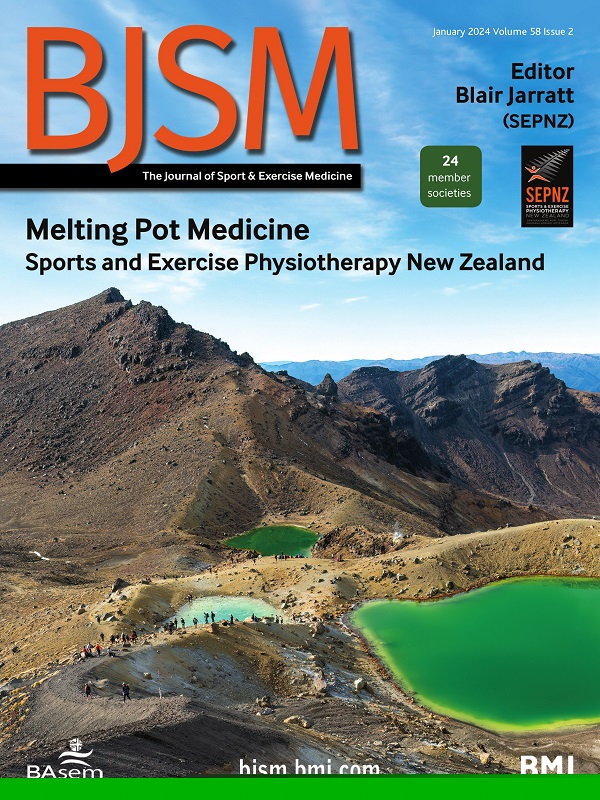Unlocking potential: how sport and exercise medicine clinicians can identify and empower neurodiverse athletes
IF 11.6
1区 医学
Q1 SPORT SCIENCES
引用次数: 0
Abstract
Have you ever encountered an athlete who suddenly shouts out or someone who seems disengaged? What was your initial reaction? Did you assume the athlete was being offensive or underperforming that day? Or did you wonder whether they might be neurodiverse? Neurodiversity refers to the natural variations in the human brain that influence how people process information, communicate and engage with their surroundings.1 It includes a range of clinical diagnoses (figure 1A) and emphasises that these conditions are normal variations of the human brain, rather than deficits.1 2 Neurodiverse athletes (NdA) often thrive in sports, leveraging their exceptional skills in attention to detail, pattern recognition, intense focus and heightened sensory awareness. Despite these strengths, they encounter distinct challenges that may not be well understood by sports and exercise medicine (SEM) clinicians, coaches, athlete staff and sporting organisations.2 This editorial aims to empower SEM clinicians to effectively identify and support NdA, particularly individuals with autism spectrum disorder (ASD). Figure 1 Comprehensive support for neurodiverse athletes. Identifying NdA presents several challenges due to stigma, vague definitions under the ’Neurodiversity’ spectrum, scant research, inadequate screening processes and limited access to specialised care through athletic programmes.1 2 The terms Asperger’s syndrome and ‘high-functioning autism’ have fallen out of use. Instead, the preferred terminology is ASD, categorised into three levels according to the amount of support needed, which fits under the broader context of neurodiversity3–5 (figure 1B). NdA may find it challenging to interpret social cues, resulting in misunderstandings or communication difficulties with teammates and athletic personnel. This can lead to feelings of isolation or unintentional exclusion from team bonding activities.6 Additionally, they might feel pressured to conform to neurotypical athlete (NtA) interaction styles, causing stress and forcing them to ‘mask’ their true selves, a …释放潜力:运动和运动医学临床医生如何识别和授权神经多样性运动员
您是否遇到过运动员突然大喊大叫或者有人看起来不合群的情况?你最初的反应是什么?你是否认为该运动员在冒犯你或当天表现不佳?还是怀疑他们可能有神经多样性?1 它包括一系列临床诊断(图 1A),并强调这些情况是人脑的正常变异,而不是缺陷。1 2 神经多样性运动员(NdA)通常在体育运动中茁壮成长,利用他们在关注细节、模式识别、高度集中注意力和增强感官意识方面的特殊技能。尽管有这些优势,但他们也会遇到一些独特的挑战,而这些挑战可能并不为运动与运动医学(SEM)临床医生、教练、运动员工作人员和体育组织所了解。2 本社论旨在增强运动与运动医学临床医生的能力,以有效识别和支持 NdA,尤其是患有自闭症谱系障碍(ASD)的个体。图 1 对神经多样性运动员的全面支持。由于污名化、"神经多样性 "谱系下的定义模糊、研究稀少、筛查程序不完善以及通过运动项目获得专业护理的机会有限,识别 NdA 面临着诸多挑战。1 2 阿斯伯格综合症和 "高功能自闭症 "这两个术语已不再使用,取而代之的是 ASD,根据所需的支持程度分为三个等级,符合神经多样性的大背景3-5 (图 1B)。聋哑人可能会发现解读社交暗示具有挑战性,从而导致误解或与队友和运动员沟通困难。6 此外,他们可能会感到有压力,必须遵从神经典型运动员(NtA)的互动方式,这给他们造成了压力,迫使他们 "掩盖 "真实的自我,而这正是神经多样性的一个大背景3-5(图 1B)。
本文章由计算机程序翻译,如有差异,请以英文原文为准。
求助全文
约1分钟内获得全文
求助全文
来源期刊
CiteScore
27.10
自引率
4.90%
发文量
217
审稿时长
3-8 weeks
期刊介绍:
The British Journal of Sports Medicine (BJSM) is a dynamic platform that presents groundbreaking research, thought-provoking reviews, and meaningful discussions on sport and exercise medicine. Our focus encompasses various clinically-relevant aspects such as physiotherapy, physical therapy, and rehabilitation. With an aim to foster innovation, education, and knowledge translation, we strive to bridge the gap between research and practical implementation in the field. Our multi-media approach, including web, print, video, and audio resources, along with our active presence on social media, connects a global community of healthcare professionals dedicated to treating active individuals.

 求助内容:
求助内容: 应助结果提醒方式:
应助结果提醒方式:


